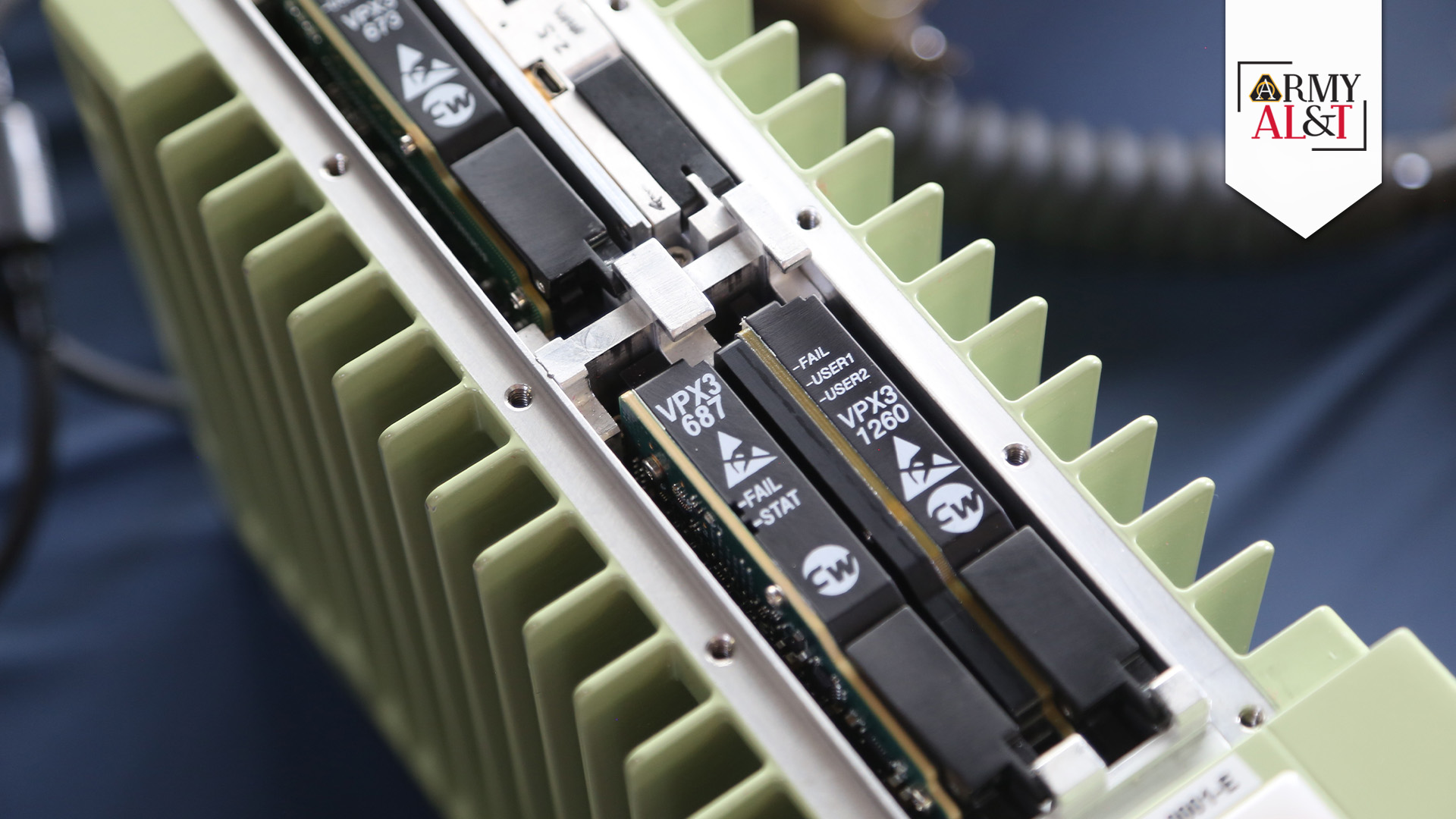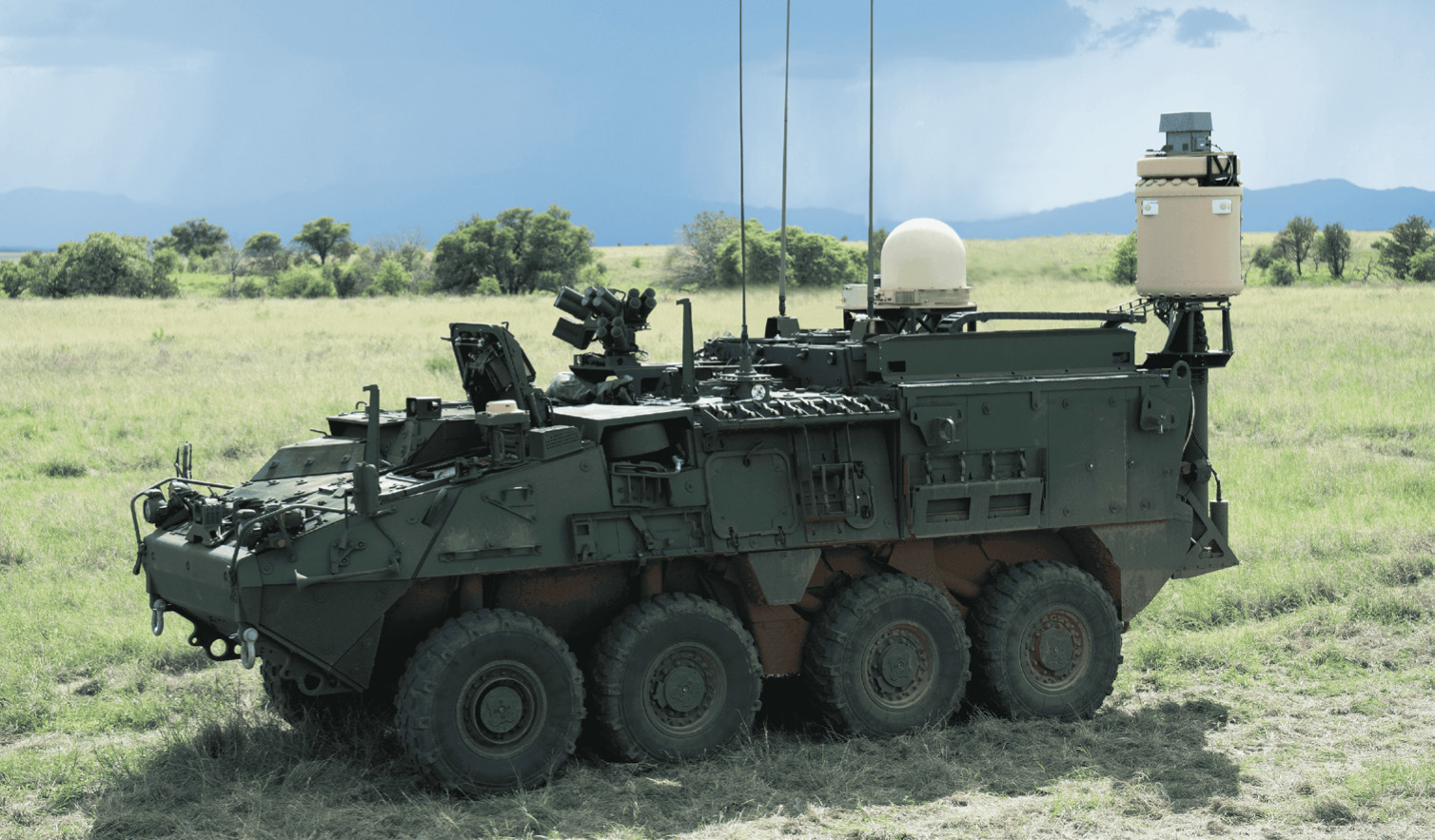
INSIDE INFORMATION
CMOSS cards are embedded with networked capabilities like positioning, navigation and timing, mission command applications or radio waveforms, which can be inserted into a common ruggedized chassis inside a tactical vehicle. (Photo by Kaitlin Newman, DEVCOM C5ISR Center)
Effectively negotiating intellectual property in Army contracting.
by Allison Weissert
The partnership between the Army and industry is vital to the ecosystem that advances mission success now, and in the future. Industry provides solutions that the Army procures, develops and fields. The challenge that exists is industry wants to protect their investments and keep their intellectual property (IP), while the government wants to avoid paying for IP it doesn’t need, or licensing after they have already paid for, or invested in, the development of the property in the first place. Both parties have a vested interest in negotiating for the proper level of rights to technical data and IP.
The acquisition of technological solutions, and the services required to sustain those products, is one of the most important issues facing both the government and private industry. While industry needs to maintain its stake in its own investments, the government purchases products that may need customization, development and sustainment within a limited budget.
Therefore, negotiating IP, including data rights, in government contracting is critical to achieving the right balance of retaining what the government requires to develop and field capabilities within budget.
UNDERSTANDING THE TERMINOLOGY
To understand the complexities of this issue, it’s important to define the terminology involved in IP and data rights.
It is also important to understand the regulations in government contracting that primarily deal with IP. They are clauses found within the Federal Acquisition Regulations (FAR) and the Defense Federal Acquisition Regulations Supplement (DFARS). Specifically, the following:
Program Executive Office for Intelligence, Electronic Warfare and Sensors (PEO IEW&S) is a complex portfolio of software and hardware systems designed to deliver advanced technologies that give Soldiers a decisive edge to pace and outpace the threat of enemies. To meet customers’ needs, PEO IEW&S relies on the innovation of industry to deliver sensors intelligence, electronic warfare and cyber solutions that provide command or decision-makers the best information possible to achieve strategic initiatives.

THE RIGHT STUFF
TLS BCT systems provide situational awareness in multidomain operations. TLS BCT implements CMOSS to assert satisfactory rights to the systems and fully understand all associated data rights of the hardware and software throughout the continuous prototyping effort. (Photo courtesy of PM EW&C)
The PEO IEW&S Contracting Division has paid particular attention to IP and data rights, as they have important implications to several products within the PEO’s portfolio. The division leverages the expertise of the Intellectual Property Law Division, Army Materiel Command Legal Center to review contract strategy and language as it refers to IP. Since PEO IEW&S is an organization that provides broad capabilities in a multidomain, cross-functional environment, the additional aspect of global partnerships must be considered. Foreign governments may not have the IP laws that are necessary for working with U.S. vendors. For example, vendors and customers must follow DOD Instruction 5230.24 for Distribution Statements on DOD Technical Information and DOD Directive 5230.25 for the Export Administration Regulations and the International Traffic in Arms Regulations.
HOW IP AND DATA RIGHTS ARE HANDLED
The mission of Project Manager Intelligence Systems and Analytics (PM IS&A) is to develop and field modernized intelligence systems that enable situational understanding on the battlefield. A key program the organization is responsible for is the Tactical Intelligence Targeting Access Node (TITAN), which is an artificial intelligence (AI)–enabled ground station currently in the rapid prototyping phase. It will receive sensor data from space, high altitude, aerial and terrestrial layer sensors to provide actionable targeting information in support of multidomain operations, Joint All-Domain Operations and Long-Range Precision Fires providing multidomain deep sensing, analysis and processing, exploitation and dissemination.
IP and data rights are a critical component of any program, and TITAN is no different. TITAN was pursued as a competitive effort leveraging an Other Transaction Agreement, and IP and data rights were considerations in evaluating proposals and prototypes during the competitive phases. Working with commercial and nontraditional vendors can necessitate different perspectives on IP. PM IS&A has been working with its contracts teams, legal teams and industry to define the appropriate IP rights for TITAN, while mandating modular and open system architecture approaches to allow for future integration of third-party components and extension of TITAN.
The TITAN prototypes include commercial-off-the-shelf, open source, developmental and government-off-the-shelf software and hardware components. PM IS&A will monitor and manage data, data rights and licensing of all products included in the TITAN baseline throughout the system life cycle to assess the effectiveness of the IP, data rights and Modular Open Systems Approach (MOSA) strategies and continue applying the lessons learned across the TITAN program and overall PM IS&A portfolio.

SOLID SELECTION
TITAN was selected by OASA(ALT) as the Army’s NDAA 2024 Section 808 Pilot, which focused on the IP and data rights as it relates to OMIT data. (Photo courtesy of PM IS&A)
TITAN was selected by the Office of the Assistant Secretary of the Army for Acquisition, Logistics and Technology (OASA(ALT)) as the Army’s National Defense Authorization Act (NDAA) 2024 Section 808 pilot, which focused on the IP and data rights as it relates to operations, maintenance, installation and training (OMIT) data. The Section 808 pilot is a congressional mandate that establishes a program for the use of innovative IP strategies that meet specific criteria described to acquire the necessary technical data rights required for the operation, maintenance, installation and training for the designated programs. With organic (unit personnel) operation and maintenance being one of the desired characteristics for TITAN, strategies associated with obtaining the appropriate OMIT data are important to achieving those objectives. This becomes a bigger focus as the TITAN program transitions from prototyping into production, which is scheduled to occur in fiscal year 2026.
The PEO IEW&S Integration Directorate assists project managers in leveraging the MOSA and ensures that this requirement is included in their acquisition artifacts. MOSA is an integrated business and technical strategy to achieve competitive and affordable acquisition and sustainment over the system life cycle. It applies a system architecture that allows major system components at the appropriate level to be incrementally added, removed or replaced throughout the life cycle of a major system platform to afford opportunities for enhanced competition and innovation. This requires these components to work together, despite coming from different industry or government solutions. The Integration Directorate assists in defining the necessary open interfaces and standards for a program to ensure that industry can retain the ownership of the IP it is concerned about while maintaining exposure to the necessary parts hardware and software that the programs need visibility into. MOSA implementation is required under DOD regulations and is key to avoiding vendor lock scenarios.
MOSA is a key initiative throughout the portfolio, to include Project Manager Electronic Warfare and Cyber (PM EW&C). PM EW&C’s mission is to develop and field integrated capabilities for spectrum warfare. Their Terrestrial Layer System – Echelons Above Brigade (TLS EAB) and Terrestrial Layer System – Brigade Combat Team (TLS BCT) systems provide situational awareness in multidomain operations. By implementing the C5ISR/Electronic Warfare Modular Open Suite of Standard (CMOSS) into the prototyping efforts of both TLS BCT and TLS EAB from their inception, the government has been able to assert satisfactory rights to the systems and fully understand all associated data rights of the hardware and software throughout the continuous prototyping effort.
Project Manager for Position, Navigation, Timing (PNT) provides mounted and dismounted solutions that enable assured PNT for multidomain operations in denied or contested environments. NorthStar will be the next-generation mounted assured PNT capability. NorthStar is intended to leverage a government-designed and -owned architecture at the center of its capability. The MOSA requirement will ensure the system is upgradable and affordable to overmatch present and future threats. The IP and data rights strategy here is to mandate that architecture at the center of the system so that, going forward, a new vendor can enter the program without IP and data rights considerations.
STRATEGIES FOR SUCCESSFUL NEGOTIATION
Because of the complexities of managing IP, each DOD program must have a detailed IP strategy. This strategy should identify and manage all IP-related matters, such as technical data, computer software deliverables, patented technologies and license rights, from the inception of a program and keep it updated throughout the entire product life cycle. This IP strategy is included in the acquisition documentation, statement of work and acquisition strategy.
Important steps must be taken when developing the statements within contracts regarding IP, including data rights. For starters, contract managers must be clear and understand what is necessary in the inception phase of a product life cycle. A program manager also needs to be prepared to monitor the contract and product throughout its life cycle, as different phases of the life cycle require different approaches. A product in sustainment may require different technical data versus a product in development, for example, and foreign partner use and global implications must be considered as well.
PEO IEW&S pays particular attention to the acquisition processes for all products within the portfolio and the implications of a thoughtful and robust plan for IP strategies. “Through diligent adherence to contracting regulations, leveraging organizational expertise, applying adaptable, negotiable strategies, developing the acquisition workforce and continuous monitoring of the portfolio, PEO IEW&S can retain the right levels of IP as necessary, while providing superior products to customers within budget,” said Nicholaus Saacks, deputy program executive officer for IEW&S. “The good news story is that we can avoid being locked into 15-year contracts with a singular vendor while allowing for competition within the community. PEO IEW&S is committed to a proactive, nuanced and deliberate approach to navigating the complexities of IP in its contracting efforts.”
CONCLUSION
For fiscal year 2025, the trend of rapid advancements in technology, including AI, continues. IP laws continue to evolve, budgets continue to shrink and vendors want to protect their investments. Managing IP and its costs will continue to be a consideration for acquisition professionals to navigate well into the future.
For more information, go to https://peoiews.army.mil.
ALLISON WEISSERT is a public affairs specialist for PEO IEW&S. She previously worked at the National Security Agency for eight years. She holds a B.S. in marketing from West Chester University.







